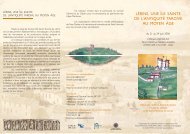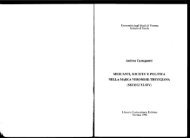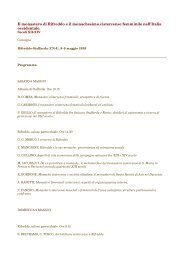Sabrina Pietrobono - Università degli Studi di Verona
Sabrina Pietrobono - Università degli Studi di Verona
Sabrina Pietrobono - Università degli Studi di Verona
You also want an ePaper? Increase the reach of your titles
YUMPU automatically turns print PDFs into web optimized ePapers that Google loves.
<strong>Sabrina</strong> <strong>Pietrobono</strong><br />
Early Me<strong>di</strong>eval settlements in the Latina Valley (Lazio, Italy):<br />
topography, archive research and survey dates (2003-2007)<br />
[A stampa in The archaeology of early me<strong>di</strong>eval villages in Europe, a cura <strong>di</strong> Juan Antonio Quirós Castillo,<br />
Bilbao 2009 (Documentos de Arqueología e Historia), pp. 57-65 © dell’autrice – Distribuito in formato<br />
<strong>di</strong>gitale da “Reti Me<strong>di</strong>evali”, www.retime<strong>di</strong>evali.it].
Early Me<strong>di</strong>eval settlements in the Latina Valley (Lazio, Italy):<br />
topography, archive research and survey dates (2003-2007)<br />
ABSTRACT<br />
The Latina Valley in Southern Lazio (Italy) was a<br />
very important long road between Rome and the South<br />
of Italy; it is an area rich in archaeological material with<br />
a history of settlement from prehistory to the present.<br />
It includes several cases of fortified hill communities<br />
that arose in the Middle ages, but little is known about<br />
the early history of the period itself in the same area.<br />
Sometimes they are situated <strong>di</strong>rectly on hilltops that<br />
exploit a middle altitude between the low plains and<br />
the high mountains, an ideal location for defense,<br />
agriculture and the exploitation of water sources. In<br />
the full Me<strong>di</strong>eval Age, at the top of some settlements,<br />
fortified castle with towers dominate the cultivated<br />
landscape: a network of settlements extends through<br />
the region offering defence from external attacks and a<br />
possibility of territorial supervision.<br />
KEYWORDS: Latina Valley; early me<strong>di</strong>eval settlements;<br />
castra; Aquinum.<br />
The «Latina Valley» is situated in the southeast<br />
portion of the Lazio region in the Province of<br />
Frosinone, constituting its central nucleus;<br />
fundamental corridor of connection between<br />
Rome and the South of Italy, crossed in ancient<br />
time by the via Latina, it unifies the Valleys of the<br />
river Sacco and that of the Liri (Fig. 1).<br />
The area presents very <strong>di</strong>fficult con<strong>di</strong>tions of<br />
research, being strongly anthropised; attention to<br />
the Middle Ages, in a systematic way, is of recent<br />
interest. In the «Carta Archeologica Me<strong>di</strong>evale.<br />
Frosinone» (<strong>Pietrobono</strong> 2006) the metho<strong>di</strong>cal<br />
work of recognition of the me<strong>di</strong>eval sites is planned<br />
on four tablets (tavolette) of the First Quadrant<br />
(Quadrante I) part of Sheet (Foglio) number 159<br />
of the «Carta d’Italia» (Map of Italy), using the<br />
archived materials both published and unpublished,<br />
by carrying on <strong>di</strong>rect exploration on the ground,<br />
surveys, graphic and photographic relief.<br />
1 Dottore <strong>di</strong> Ricerca, <strong>Università</strong> <strong>degli</strong> stu<strong>di</strong> de L’Aquila.<br />
<strong>Sabrina</strong> <strong>Pietrobono</strong> 1<br />
The searches conducted between 2003 and 2007<br />
have progressively connected the starting area (Fig.<br />
2) to a big sector in the eastern part of Frosinone,<br />
inclusive in Sheet n. 160 of the «Carta d’Italia» (Fig.<br />
3), delimited by the rivers Liri and Melfa, widening<br />
the perspective of investigation to the historical<br />
aspect: in fact the research proceeds to integrate in<br />
the «Roman» area or commonly known as the «the<br />
Pope’s Country» (Campagna del Papa), of which<br />
Frosinone was part, the «southern» area where the<br />
abbey of Montecassino excells, that Lombard and<br />
Norman «Campania» later becoming the Svevian,<br />
Angioine and Aragonese «Terra <strong>di</strong> Lavoro»; these<br />
two historical regions today are joined into the<br />
modern Lazio, set to comparison, they give<br />
interesting sprout of reflection.<br />
The chronological viewpoint is atypical having<br />
preferred to start from the Late Ancient phase,<br />
hence from the IV century A. D., to the central<br />
centuries of the Middle Age, though analyzing the<br />
results in modern age, keeping in consideration<br />
the key transformation marked by the «industrial<br />
revolution» which has had its most irreversible<br />
conclusion in the ‘60 and ‘70 of the last century<br />
and has definitely altered the environmental,<br />
historical, social and economic balance present<br />
throughout the centuries.<br />
Despite, over the last years, searches proposing<br />
the study of the territory, through consolidated<br />
methodologies particularly for the phases pre –<br />
Romans and Romans (bibl. Corsi 2007:455-457)<br />
have overlapped, the data shown in the most<br />
recent syntheses are necessarily bounded - for the<br />
data of recognition - to the investigation developed<br />
by the Cana<strong>di</strong>an research group of the Mc Master<br />
University (Hamilton, Ontario), conducted in the<br />
low Latina Valley during the ‘70’s and the ‘80s, the<br />
results of the preventive investigations by the<br />
Soprintendenza Archeologica del Lazio (Supervisor<br />
and Archaeological State Organization of the<br />
Lazio) during the <strong>di</strong>gging investigations for the<br />
construction of the high speed line (bibl. Bellini<br />
1995) are inevitable.
58 SABRINA PIETROBONO<br />
Fig. 1. Lazio, Central Italy (Wikipe<strong>di</strong>a).<br />
In parallel, the revision of the publications was<br />
necessary and the local and tra<strong>di</strong>tional<br />
historiography was criticized, because not always<br />
adequately filtered.<br />
Despite the lack of systematic excavations does<br />
not show up on the first phases of the installations,<br />
the results have been encouraging: the strengthened<br />
and deepened re-rea<strong>di</strong>ng of the publications in a<br />
critical way gives the possibility to progressively<br />
observe every single site in<strong>di</strong>vidualized and this<br />
study has already resolved past misunderstan<strong>di</strong>ngs<br />
and new keys of rea<strong>di</strong>ng of the known information<br />
connected to the <strong>di</strong>scovers (bibl. <strong>Pietrobono</strong><br />
2002b; 2003:167-184).<br />
The exam of those settlements in the Lazio<br />
region was inevitably represented to remind the<br />
historical investigations conducted in the past (bibl.<br />
Toubert 1997), it has been considered not just the<br />
strengthened installation enucleated from the<br />
castles and from the castra: but also monasteries,<br />
casalia, villas, curtes and every element that could<br />
suspect the presence of shed inhabited area.<br />
The area in examination coincides a lot with<br />
the territory of the longobard counties of Sora,<br />
Aquinum and Atina, next to the border of the vast<br />
Cassino area also called Terra S. Bene<strong>di</strong>cti, <strong>di</strong>rectly<br />
administered from the great abbey founded by S.<br />
Bene<strong>di</strong>ct, while on the Roman slope it includes the<br />
<strong>di</strong>oceses of Veroli and Ferentino.<br />
In this area we have been able to isolate every<br />
element of the me<strong>di</strong>eval inhabited landscape,<br />
inclusive environmental more tightly data (as those<br />
agrarian and economic, signals of cultivations, fish<br />
catching, fittings of bree<strong>di</strong>ng, etc). The demand to<br />
compare with projects analysed in other regional<br />
areas has developed a methodology that now<br />
crosses the tra<strong>di</strong>tional topographical investigation<br />
in the area. The bibliographic references have been<br />
the stu<strong>di</strong>es of Tuscany by Francovich, (Ginatempo,<br />
Francovich 2000:7-24); the investigations by F.<br />
Re<strong>di</strong> (Re<strong>di</strong> 2007:185-202) and P. Peduto (Peduto<br />
2008), but it goes on to gradually adapt elements<br />
inferred <strong>di</strong>rectly by the archive <strong>di</strong>sciplines applied<br />
to the study of the territory.<br />
1. FROSINONE<br />
Today the city-centre in the chief town of the<br />
area has vast problems of research. The continuity<br />
of life between the late age and the me<strong>di</strong>eval one is<br />
object of research due to it being mentioned in the
EARLY MEDIEVAL SETTLEMENTS IN THE LATINA VALLEY (LAZIO, ITALY): TOPOGRAPHY, ARCHIVE RESEARCH ... 59<br />
Fig. 2. From F°. 159 (Frosinone), Carta d’Italia, IGM. 1. Frosionone; 2.<br />
Manianum; 3. Torrice; 4. Ceccano; 5. Pofi; 6. Casale and Castro dei<br />
Volsci.<br />
Liber Pontificalis where Frusino can be read as the<br />
birthplace of the bishop of Rome, Ormisda, and<br />
perhaps the motherland of his child Silverio, like<br />
the mention to Ludovicianum dated 817 (sources<br />
in <strong>Pietrobono</strong> 2006:38).<br />
The central nucleus of the castrum probably<br />
coincides with the area so-called Civita, on the top<br />
of the hill where the historical center was based,<br />
closed by a wall circuit, reconstructed on the base<br />
of the ancient cadastral planimetries<br />
(Pie trobono 2007a:109-110).<br />
2. MAniAnuM<br />
From the list of the possessions of the<br />
Chapter of the Cathedral of Veroli in 959,<br />
in the proximities of the <strong>di</strong>tch called Bagno<br />
(=Bath), situated between Frosinone and<br />
Veroli, we know the extension of a series<br />
of important rural funds, among which we<br />
recognize Manjanus in quo est lacus, cum<br />
piscatoriis suis cum silvis et terris cum<br />
omnibus ad eum pertinentibus posito<br />
territorio verulano, miliaria ab urbe Rome<br />
sexaginta [...] (<strong>Pietrobono</strong> 2006: 118-<br />
119): at the moment we are unable to<br />
identify with an exact spatial location and<br />
human definition, even if recently the<br />
following can be read «presenza demica ivi<br />
stabilmente residente. il fondo <strong>di</strong> Maniano,<br />
quin<strong>di</strong>, si configura come un vero e proprio<br />
centro agglutinante <strong>di</strong> popolamento,<br />
proba bilmente costruito anche prima della<br />
fine del X secolo ed esistente almeno fino<br />
alla metà del Xii, facente parte dei beni<br />
appartenenti all’autorità vescovile<br />
verolana» (Stasolla, Annoscia, Del<br />
Ferro 2008). Actually it is a rural fraction<br />
to north-east of the ancient Frusino.<br />
3. TORRICE<br />
Placed along the road axle of the via<br />
Latina, delimited to the north by a hill of<br />
quota 321 metres, from the mid tenth<br />
century, it is defined as oppidum. The<br />
name brings one to think of a native small<br />
tower of a border, which would suit for its<br />
external position, towards the west, within<br />
the territory of Veroli; Torrice was the<br />
centre of a small fortress, attested in 1264, of which<br />
today there are just litle supposed branches, situated<br />
in dominant position (<strong>Pietrobono</strong> 2007a:115).<br />
4. CECCANO<br />
It rises in Fabrateria Vetus along the river<br />
Sacco. Towards the middle of the VIII century
60 SABRINA PIETROBONO<br />
Fig. 3. From F°. 160 (Cassino), Carta d’Italia, IGM. 7. Arce; 8.Ceprano; 9. Aquinum; 10. Castrocielo and Villa Euchelia; 11. Pontecorvo; 12. Parito, Pie<strong>di</strong>monte and Villa S. Lucia; 13. Santopadre.
EARLY MEDIEVAL SETTLEMENTS IN THE LATINA VALLEY (LAZIO, ITALY): TOPOGRAPHY, ARCHIVE RESEARCH ... 61<br />
the Ciccanense castellum was conquered by the<br />
troops of the Lombard King Astolfo; after Stephen<br />
II contracted the restitution to the Church<br />
(<strong>Pietrobono</strong> 2006:41-42). The village does not<br />
keep structures clearly linked to high me<strong>di</strong>eval<br />
age, the rea<strong>di</strong>ng of cadastral maps has led to<br />
hypothesize a circuit wall containing the top of<br />
the hill, as in the case of nearby Frosinone<br />
(<strong>Pietrobono</strong> 2006:180-187).<br />
5. POFI<br />
Stone quarries near the <strong>di</strong>tch Moringo exploit<br />
basalt due to the Ernico volcanism. In this subject<br />
conducive to the supply of materials and water,<br />
easily connected to the ancient road-net<br />
continued in use, surrounded by forests and<br />
lands that return traces of Roman settlements,<br />
appears in 1019 the name of the castrum of Pofi<br />
(<strong>Pietrobono</strong> 2006:46-47); the place name has<br />
an uncertain etymology. There is no known data<br />
of excavation that may clarify if, on the hill<br />
hosting the centre today, at a height of 283 m., a<br />
village could have been before the castrum, but<br />
the useful position privileged to the control of<br />
the roads, with a visual dominion over the Latina<br />
Valley, leads not to <strong>di</strong>scard the possibility of an<br />
early planting and more intensive investigations<br />
(<strong>Pietrobono</strong> 2007a:116).<br />
6. CASALE AND CASTRO DEI VOLSCI<br />
Today Castro dei Volsci is a rural town,<br />
inclu<strong>di</strong>ng a fortified village on top of a hill, quota<br />
385 m., with little villages in a flat area next to it<br />
and scattered in the territory. In a location, Casale<br />
<strong>di</strong> Madonna del Piano, during the ‘80s and the<br />
‘90s, the Soprintendenza Archeologica del Lazio<br />
dug a Roman villa now recognized in the<br />
archaeological site (Bellini 1992): in the southern<br />
area of the Lazio region it is one of the most<br />
important constructions for the study of the<br />
<strong>di</strong>fferent phases of settlement continuity between<br />
the late Roman republic and the Early Middle Age,<br />
crucial element in understan<strong>di</strong>ng the changes in<br />
the area. The <strong>di</strong>scovery of an ecclesiastical buil<strong>di</strong>ng<br />
attracts the largest process of transformation of<br />
late antique villas witnessed in other European<br />
contexts (Chavarría Arnau 2004:7-19). The<br />
materials obtained from excavation confirmed the<br />
continuity of the Christian community to the<br />
Carolingian age. The most significant element is a<br />
great ciborium found in separate sheets and a little<br />
related column, between the structures (1992) and<br />
reassembled in the Archaeological Civic Museum<br />
(situated in Castro dei Volsci), as well as some<br />
fragments of pottery «Forum Ware» (Bellini<br />
2001:71). The site overlooking Castrum Castri<br />
(<strong>Pietrobono</strong> 2007a:116-117) arises as a primary<br />
element of continuity in the attendance of the<br />
area, even if it the historical relationship between<br />
the site of the Casale and the castrum is not so<br />
clear; the data collection of the me<strong>di</strong>eval stage<br />
project the research even in settlement contexts;<br />
it is the case of the location Acquapuzza, where<br />
local reports set the presence of areas of clay<br />
fragments and Roman and me<strong>di</strong>eval walls (De<br />
Rossi 1980:237).<br />
7. ARCE<br />
From the second half of the seventh century<br />
appears Arcis: found in the list of Ravennatis<br />
Anonymi Cosmographia (IV, 33, 8-12), after<br />
Fabraria and Mulfe (Melfa River), the settlement<br />
lies on the hill where there are the two modern<br />
villages of Arce and Rocca d’Arce, along a route<br />
that <strong>di</strong>ssociate from the Via Latina, falls into the<br />
hinterland, <strong>di</strong>rect to the town of Sora; then<br />
appointed by Paul Deacon (Hist. Lang. VI, 27),<br />
Arcis became a cornerstone of the Lombard border<br />
to the Papal possessions in the late seventh and<br />
the beginning of the eighth century (Hayes-<br />
Martini 1994:53; <strong>Pietrobono</strong> 2007b:73-113).<br />
8. CEPRANO<br />
Accor<strong>di</strong>ng to the authoritative sources it was<br />
built on the site of Fregellanum, known on via<br />
Latina during the imperial time, the castellum<br />
Ceperani was first mentioned in 987: part of the<br />
walls on the western side, are severely damaged;<br />
the technique used refers to types in opus<br />
quadratum with square blocks for reuse, (with<br />
variable modu le) and an input, called Porta<br />
Romana or Porta Vecchia opened on the Western<br />
Front of castrum, in front of them was a double<br />
moat, instinctively understood by the name of a<br />
street, via del Carbonale (<strong>Pietrobono</strong><br />
2007a:112-114).
62 SABRINA PIETROBONO<br />
9. AquinuM<br />
The Roman town returned traces of<br />
<strong>di</strong>scontinuous attendance between the late Roman<br />
period and the early Middle Ages. Researches<br />
conducted in the’70s by a group of study of the<br />
Cana<strong>di</strong>an University Mac Master had found a<br />
<strong>di</strong>fferent <strong>di</strong>stribution of ceramic artefacts collected<br />
on the urban area, in particular the fin<strong>di</strong>ngs of the<br />
late age were concentrated around the main streets,<br />
next to the western wall at the Roman Door, the<br />
so-called Capitolium and in the southern areas of<br />
the city. Rare fin<strong>di</strong>ngs of the eighth century<br />
(<strong>Pietrobono</strong> 2008) are reported in the areas<br />
imme<strong>di</strong>ately behind the western wall. We<br />
considered conservatively that the northern part<br />
of the urban environment, particularly in the north<br />
eastern - perhaps not in the area of the so-called<br />
Capitolium - has been gradually phased out over<br />
time, the dwellings seem to concentrate along the<br />
axis of the central and southern via Latina, between<br />
the walls (Hayes-Martini 1994:171-172).<br />
In 1994 I started the reorganization of information<br />
and existing data: the result was to define the search<br />
for a settlement shift from the Roman town, in the<br />
lower Central Latina Valley and organized on a<br />
plateau called S. Pietro Vetere, in the west of a deep<br />
depression in natural travertine bench called Vallone<br />
delle Peutime. An agglomeration of houses<br />
concentrated around a low me<strong>di</strong>eval castle from<br />
which the current town took home is now situated<br />
on a plateau to the east of the Vallone (<strong>Pietrobono</strong><br />
2000:94-96). In an interme<strong>di</strong>ate stage the stabilization<br />
of a complex wall is placed. It contains the portion<br />
of the plateau at Aquinas in the south east of the<br />
ancient city, known as Malanova. During the ‘90s<br />
the local historiography (see Corsi 2007:480-481)<br />
was convinced that a Lombard settlement was<br />
formed at the end of the sixth century, for the<br />
presence next the wall of a Door called that of St.<br />
Lorenzo or Capuana, then considered certainly<br />
Roman, but that the research carried out defines the<br />
contrary, such as access to the old me<strong>di</strong>eval city<br />
(<strong>Pietrobono</strong> 2002a; 2002b; 2003). The hypothesis<br />
of an alleged Lombard settlement, in the end of the<br />
sixth century, was therefore set aside temporarily,<br />
pen<strong>di</strong>ng reliable archaeological data. The buil<strong>di</strong>ng<br />
or rebuil<strong>di</strong>ng of the long wall of containment to the<br />
south of St. Lorenzo or Capuana Door is<br />
understandable when linked to the process of<br />
fortification included in the VIII-X century in<br />
southern Lazio (<strong>Pietrobono</strong> 2008), recognized in<br />
Gaeta (Crova 2005:69-86) or at Aquinum, probably<br />
within the same Tower of S. Gregory, recently<br />
analyzed by Paolo Peduto (2005:99-102). Aquinum<br />
emerges during the ninth century as the seat of a<br />
Lombard Gastaldo, Rodoaldo, the builder of the<br />
castle of Pontecorvo (infra).<br />
10. CASTROCIELO AND VILLA EUCHELIA<br />
The Roman Villa Euchelia at the foot of Mount<br />
St. Sylvester at Castrocielo, once called Palazzuolo,<br />
at 256 m, was reoccupied in the fourth century;<br />
materials that come to the sixth century have been<br />
collected in the plant, situated on a plateau dated<br />
II century B.C. and with the tank, the functional<br />
continuity of use of the buil<strong>di</strong>ng. Recent<br />
investigations have been possible to infer a<br />
continuous settlement for the whole Early Middle<br />
Ages (Bellini 2004:79; 85:86). On top of the<br />
mountain overlooking Castrocielo, lack of water,<br />
therefore not conducive to the continuity of life,<br />
lies a fortress where the object of some<br />
investigations and preventive excavations<br />
(Marazzi et alii 2008), documentation and<br />
me<strong>di</strong>eval name-place (Bloch 1986:204-205),<br />
suggest an alternation of settlements in the pretenth<br />
century. Under the rock there are some<br />
houses of the village clearly visible, then abandoned<br />
in modern times (Bertani 2000:90-95).<br />
11. PONTECORVO<br />
The castle was founded between 861 and 872,<br />
as recalled by the Chronicles of Montecassino<br />
(sources in Bloch 1986:395) for the will of<br />
Radoald, gastaldus, and it was planted on a villa in<br />
the ager of Aquinum, in correspondence of a<br />
passage on the river Liri, onto a travertine terrace<br />
at 97 m which emerges from the surroun<strong>di</strong>ng<br />
context of alluvial matrix. The walls reveal<br />
elements in common with the me<strong>di</strong>eval walls<br />
recognized in the Latina Valley (Ceprano,<br />
Aquinum, Torre San Gregorio, infra).<br />
12. PARITO, PIEDIMONTE AND VILLA<br />
S. LUCIA<br />
At Parito, in the territory of the town of<br />
Pie<strong>di</strong>monte S. Germano, at Aquinum, the
EARLY MEDIEVAL SETTLEMENTS IN THE LATINA VALLEY (LAZIO, ITALY): TOPOGRAPHY, ARCHIVE RESEARCH ... 63<br />
reconnaissance of the Cana<strong>di</strong>an research team<br />
identified along the route of a road called<br />
Pedemontana, originally founded maybe in pre-<br />
Roman Age, between the coor<strong>di</strong>nates 969960 and<br />
969950, a Roman settlement of considerable wealth.<br />
The fin<strong>di</strong>ngs in this place are fully from the sixth<br />
century, and some ceramic pieces can be traced<br />
back to the early Middle Ages. In the locality now<br />
known Pari to (Fig. 4, No. 1) is just one of the nuclei<br />
of a wide area that returns traces of settlements,<br />
perhaps a village or an urban area in the settlement,<br />
where south west was then implanted the Castle<br />
called Pie<strong>di</strong>monte (Hayes-Martini 1994:51; 192-<br />
195). Me<strong>di</strong>eval sources lead now in this <strong>di</strong>strict to<br />
Fig. 4. From CTR 403060: Pie<strong>di</strong>monte, località Parito, n.1; Pie<strong>di</strong>monte, n. 2; S. Lucia, n. 3.<br />
recognize a structured settlement that emerges<br />
fully in the eleventh century, in the wedge formed<br />
by the overhanging Parito Hill, said Santa Luce (Fig.<br />
4, n. 2), from the site Villa S. Lucia to the complex<br />
of castrum attested to half of the eleventh century<br />
(Fig. 4, No. 3). In 1042 (Leccisotti 1972:214, doc.<br />
1312, n. 29), in a land of Pie<strong>di</strong>monte called Pariti<br />
there was an area planted like a vineyard and land<br />
bacciba; in 1052, the castle is mentioned in a trial<br />
for possession of a plot of land at Fontanelle, during<br />
which men intervened Jhoanne, Petrus and<br />
Teodoricus were natibi, et avitatori de Castello pede<br />
de monte (...); Jhoanne was filio Guelti avitator in<br />
loco at S. Lucia, (Gattola 1733:75). The term
64 SABRINA PIETROBONO<br />
natibi brings the existence of the castle at least a<br />
few decades before, in fact across the mention of<br />
1042. S. Lucia is an open area, which attests to the<br />
fact the persistence of population in the same<br />
location from the Roman to me<strong>di</strong>eval, though<br />
without being able to demonstrate the perfect<br />
continuity in time. The morphological con<strong>di</strong>tions,<br />
the presence of fertile land within short <strong>di</strong>stance<br />
and of Roman structures and perhaps also from<br />
reuse, the possibility of greater security they had to<br />
facilitate the maintenance of the population. Given<br />
the presence of the village of Pie<strong>di</strong>monte, the<br />
problem is to verify the intended use of the hill on<br />
which rests the castrum at prior stages to its<br />
organization and to assess its role in connection to<br />
the Parito’s villa and Villa Santa Lucia settlements<br />
localised to its north.<br />
13. SANTOPADRE<br />
A few items to confirm the local tra<strong>di</strong>tion that<br />
recognizes in Santopadre the center of the preexisting<br />
Castroforolo in the seventh century, as<br />
surely as the only element back to me<strong>di</strong>eval times,<br />
but hardly before the second half of the thirteenth<br />
century, is a tower-based circulated at the highest<br />
point of the hill of the castle, being restored in<br />
<strong>di</strong>fferent times (<strong>Pietrobono</strong> 2002a).<br />
CONCLUSION<br />
If, during the sixth century there was a fracture<br />
or not clear in the social organization and<br />
production it is not possible to say (Corsi<br />
2007:488-491), but the early me<strong>di</strong>eval settlement<br />
is on a reorganization of populated fabric that has<br />
contracted since the late antiquity in a particular<br />
way in rural villages throughout the area surveyed,<br />
from Castro dei Volsci to Aquinum.<br />
In the short space of this article it is impossible<br />
to exhaust the analysis of the early me<strong>di</strong>eval context<br />
of the Latina Valley: it has revealed a number of<br />
villages and settlements, fortified or not, founded<br />
in the early Middle Age, but is not yet possible to<br />
draw up comprehensive conclusions on the stages<br />
without interruption of continuity in contexts<br />
identified. Those <strong>di</strong>fferent sites give the possibility<br />
to think, as in the case of Pie<strong>di</strong>monte and Castro<br />
dei Volsci, <strong>di</strong>scovering complex relationships<br />
between quite important Roman sites and me<strong>di</strong>eval<br />
residences built in their proximities. In the case of<br />
Roman cities, considered in the demarcated area,<br />
like Frusino (Frosinone), Fabrateria Vetus<br />
(Ceccano) and the same Fregellanum / Ceperanum,<br />
the ancient sources suggest gradual steps towards<br />
the new form of fortified village, while in Aquinum<br />
written and archaeological evidences slowly let<br />
complex transformation. Particu lar cases like<br />
Fabrateria nova and Fregellae were excluded from<br />
the <strong>di</strong>scussion (Fig. 3, A and B), referring to another<br />
location the examination of interamna Lirenas<br />
(Fig. 3, C). New rea<strong>di</strong>ngs to some settlements<br />
remain to be explored further, however (eg Pofi,<br />
Manianum), in the hills of the Latina Middle<br />
Valley.<br />
A network of settlements extends through the<br />
region offering defence from external attacks and<br />
a possibility of territorial supervision. Sometimes<br />
they are situated <strong>di</strong>rectly on hilltops that exploit a<br />
middle altitude between the low plains and the<br />
high mountains (Pontecorvo), an ideal location<br />
for defence, agriculture and the exploitation of<br />
water sources. In the full Me<strong>di</strong>eval Age, at the top<br />
of some settlements (Castrocielo; Pie<strong>di</strong>monte;<br />
Rocca d’Arce; Torrice), a fortified castle with<br />
towers dominate the cultivated landscape.<br />
BIBLIOGRAFIA<br />
Bellini G.R., 1992, (ed), Archeologia Me<strong>di</strong>evale<br />
nel Lazio: l’inse<strong>di</strong>amento <strong>di</strong> Castro dei Volsci,<br />
Roma.<br />
———, 1995 (ed), Archeologia ed alta velocità.<br />
Storia <strong>di</strong> un connubio necessario. il monitoraggio<br />
archeologico, Roma.<br />
———, 2004, L’ager <strong>di</strong> Aquinum, Lazio e Sabina, 2,<br />
Roma, pp. 77-91.<br />
———, 2001, Museo Civico Archeologico, Frosinone.<br />
Bertani B., 2000, notizie storiche su Castrocielo,<br />
Montecassino.<br />
Bloch H., 1986, Montecassino in the Middle Age,<br />
vol. I-III, Roma.<br />
Chavarría Arnau A. 2004, Considerazioni sulla<br />
fine delle ville in Occidente, Archeologia<br />
Me<strong>di</strong>evale, XXXI, 7-19.<br />
Corsi C. 2007, Tunc in cospectu viri dei placuit ut<br />
in loco eodem terram foderent». Inse<strong>di</strong>amento<br />
e paesaggio nel territorio <strong>di</strong> Cassino tra S.<br />
Benedetto e Gregorio Magno, L’Orbis<br />
Christianus Antiquus <strong>di</strong> Gregorio Magno, a<br />
cura <strong>di</strong> L. Pani Ermini, Roma, pp. 456-491.
EARLY MEDIEVAL SETTLEMENTS IN THE LATINA VALLEY (LAZIO, ITALY): TOPOGRAPHY, ARCHIVE RESEARCH ... 65<br />
Crova C., 2005, inse<strong>di</strong>amenti e tecniche costruttive<br />
me<strong>di</strong>evali. il Latium a<strong>di</strong>ectum e la Terra<br />
Laboris, Montecassino.<br />
De Rossi G.M., 1980, il Lazio Meri<strong>di</strong>onale,<br />
Roma.<br />
Hayes J. W., Martini I. P., 1994 (ed.),<br />
Archaeological Survey in the Lower Liri Valley,<br />
Central italy, B.A.R. International series 595,<br />
Oxford.<br />
Gattola E. 1733, Historia Abbatiae Cassinensis<br />
per saeculorum seriem <strong>di</strong>stribuita, I, Venetis.<br />
Ginatempo M., Francovich R., 2000 (ed),<br />
Castelli. Storia e archeologia del potere nella<br />
Toscana me<strong>di</strong>evale, i, introduzione, Firenze.<br />
Leccisotti T., 1972, (ed), Abbazia <strong>di</strong><br />
Montecassino. i regesti dell’archivio, Vii,<br />
Roma.<br />
Marazzi F., Frisetti A, Gobbi A, Di Cosmo L.,<br />
2008, Castello <strong>di</strong> Castrum Coeli (Colle San<br />
Magno - FR), campagna 2003-2004. Risultati<br />
dei saggi <strong>di</strong> scavo e dell’analisi stratigrafica<br />
<strong>degli</strong> alzati, Annali università Suor Orsola<br />
Benincasa, 2004-2006, pp. 47-72.<br />
Peduto P., 2005, Bacini, tarsie e spolia nelle<br />
costruzioni in Italia Meri<strong>di</strong>onale al tempo <strong>degli</strong><br />
ultimi Longobar<strong>di</strong> e dei Normanni, Apollo XXi,<br />
pp. 99-114.<br />
———, 2008, (ed), Mercato S. Severino nel Me<strong>di</strong>oevo.<br />
il castello e il suo territorio, Firenze.<br />
<strong>Pietrobono</strong> S., 2000, L’Aquinum <strong>di</strong> san Costanzo:<br />
ipotesi su continuità e trasformazioni della<br />
civitas <strong>di</strong> età classica, Costanzo <strong>di</strong> Aquino (Vi<br />
sec.). il suo tempo – i suoi luoghi – il suo culto,<br />
a cura <strong>di</strong> F. Carcione, Venafro, pp. 80 – 110.<br />
———, 2002a, Aquino, Santopadre e la Valle del<br />
Liri: ipotesi e corrispondenze tra storia,<br />
topografia me<strong>di</strong>evale e leggenda <strong>di</strong> San Folco <strong>di</strong><br />
Aquino, padre pellegrino, Folco <strong>di</strong> Santopadre.<br />
un pellegrino inglese me<strong>di</strong>evale nella Valle del<br />
Liri. Tra storia e leggenda, a cura <strong>di</strong> F. Carcione,<br />
Venafro, pp. 105 – 165.<br />
———, 2002b, La via Latina nel Me<strong>di</strong>oevo: l’apporto<br />
delle fonti me<strong>di</strong>evali allo stu<strong>di</strong>o della viabilità<br />
nel territorio <strong>di</strong> Aquinum, La viabilità me<strong>di</strong>evale<br />
in italia, contributo alla carta archeologica<br />
me<strong>di</strong>evale, a cura <strong>di</strong> Stella Patitucci Uggeri,<br />
Firenze, pp. 197 – 228.<br />
———, 2003, Aquinum: Porta Capuana o <strong>di</strong> San<br />
Lorenzo. Una nuova interpretazione, Journal<br />
of ancient topography, XIII, pp. 167 - 184.<br />
———, 2006, Carta Archeologica Me<strong>di</strong>evale,<br />
Frosinone F°. 159, quadrante i, Formae italiae<br />
Me<strong>di</strong>i Aevi, Firenze.<br />
———, 2007a, Gli inse<strong>di</strong>amenti fortificati nella<br />
Dio cesi <strong>di</strong> Veroli: primo contributo, Archeologia<br />
del paesaggio me<strong>di</strong>evale. <strong>Stu<strong>di</strong></strong> in memoria <strong>di</strong><br />
Riccardo Francovich, a cura <strong>di</strong> S. Patitucci<br />
Uggeri, Firenze, pp. 105-136.<br />
———, 2007b, Per la topografia della Contea<br />
d’Aquinum e dei feu<strong>di</strong> aquinati: la viabilità<br />
me<strong>di</strong>evale tra Arce ed Aquinum. Problemi<br />
metodologici e prospettive <strong>di</strong> ricerca, Suavis<br />
terra, inexpugnabile castrum. L’Alta Terra <strong>di</strong><br />
Lavoro dal dominio svevo alla conquista<br />
angioina, a cura <strong>di</strong> F. Delle Donne, Frosinone,<br />
pp. 73-113.<br />
———, 2008, Nuovi dati per lo stu<strong>di</strong>o della<br />
cattedrale <strong>di</strong> Aquinum in età paleocristiana ed<br />
altome<strong>di</strong>evale, XV Congresso internazionale <strong>di</strong><br />
Archeologia Cristiana, Toledo 8-12 Settembre<br />
2008, cs.<br />
Re<strong>di</strong> F., 2007, Per una carta archeologica<br />
me<strong>di</strong>evale: L‘Aquila e il territorio, Archeologia<br />
del paesaggio me<strong>di</strong>evale. <strong>Stu<strong>di</strong></strong> in memoria <strong>di</strong><br />
Riccardo Francovich, a cura <strong>di</strong> S. Patitucci<br />
Uggeri, Firenze, pp. 185-202.<br />
Stasolla F.R., Annoscia G., Del Ferro S., Il<br />
ruolo delle signorie monastiche<br />
nell’articolazione del popolamento nel Lazio<br />
meri<strong>di</strong>onale, Geografie del popolamento. Casi<br />
<strong>di</strong> stu<strong>di</strong>o, meto<strong>di</strong> e teorie, 24-26/9/2008, http://<br />
www.archeogr.unisi.it/asiaa/files/geopop/<br />
stasolla.pdf<br />
Toubert P., 1997, Dalla terra ai castelli.<br />
Paesaggio, agricoltura e poteri nell‘italia<br />
me<strong>di</strong>evale, a cura <strong>di</strong> Sergi G., Torino.
















